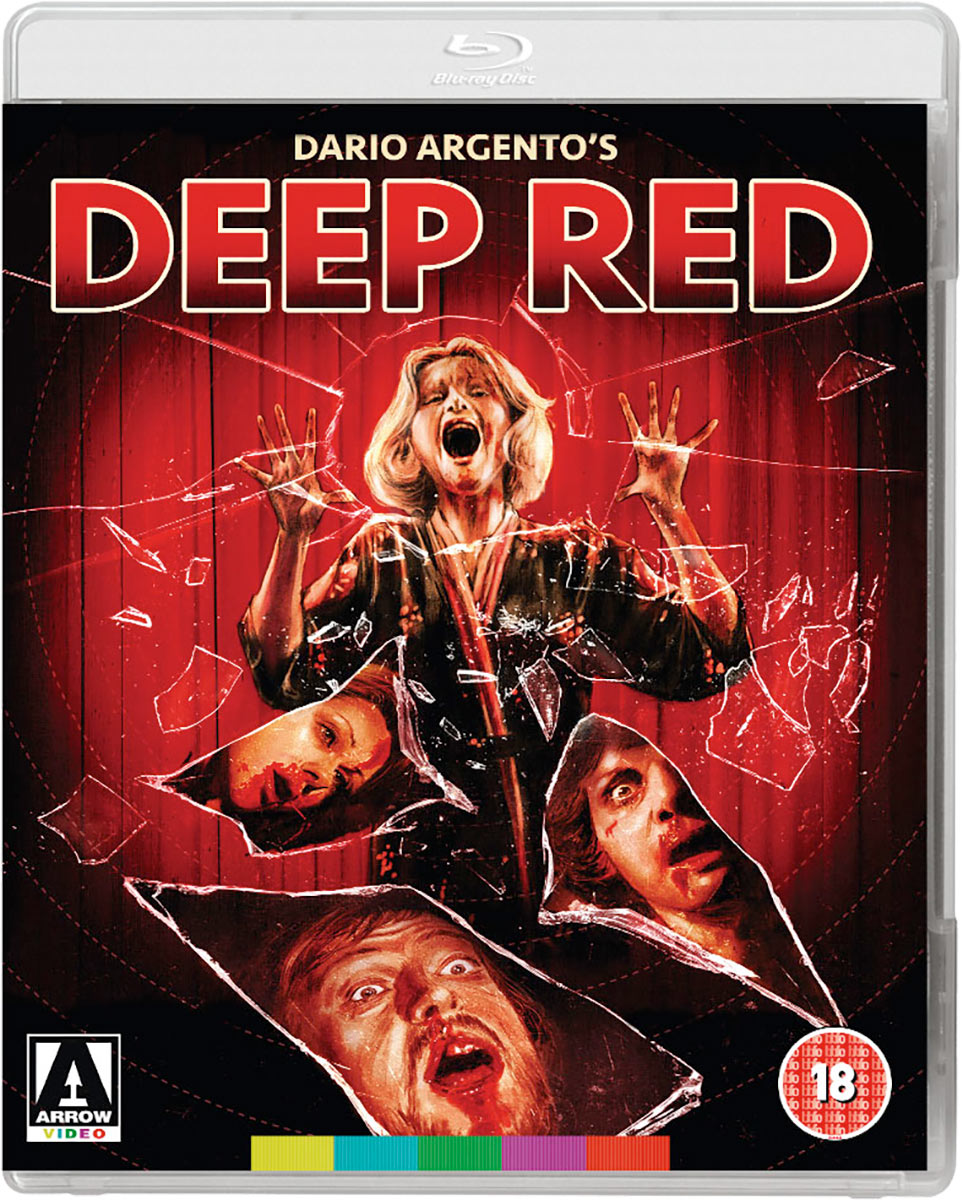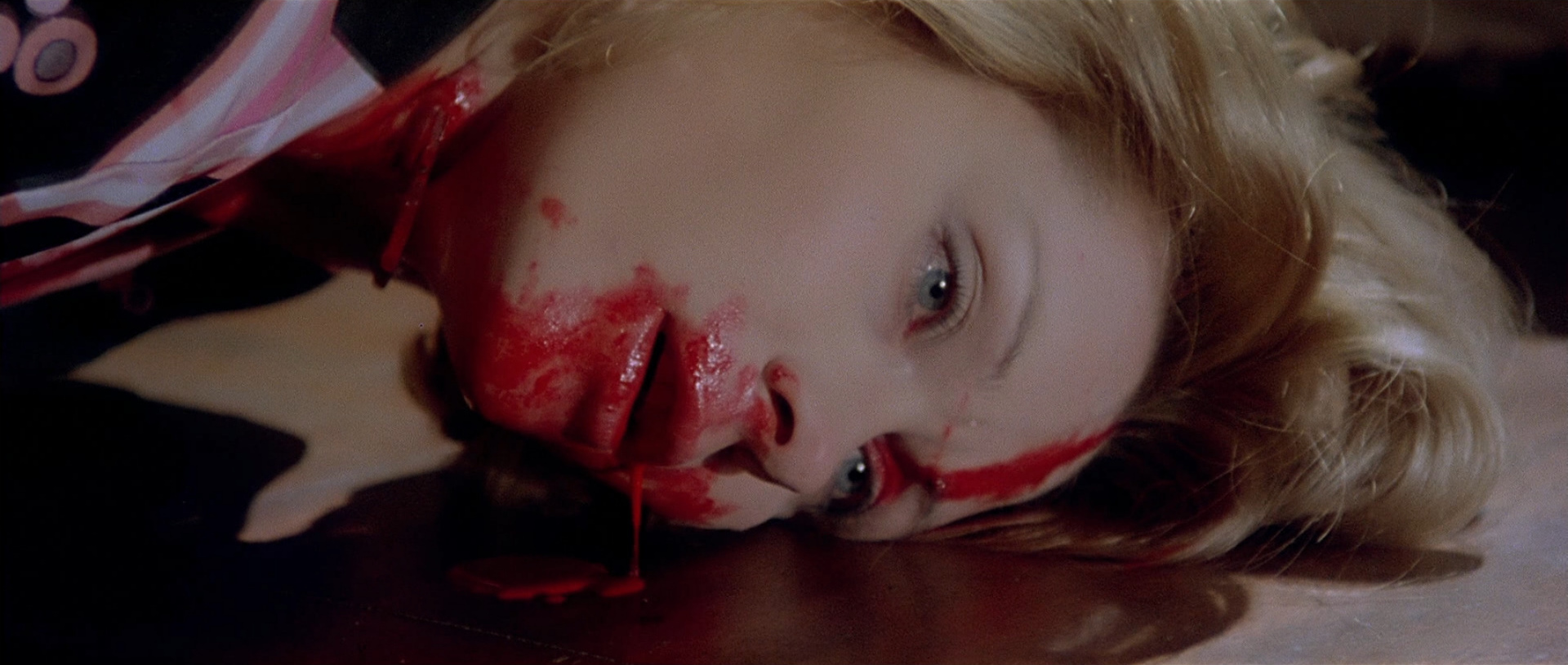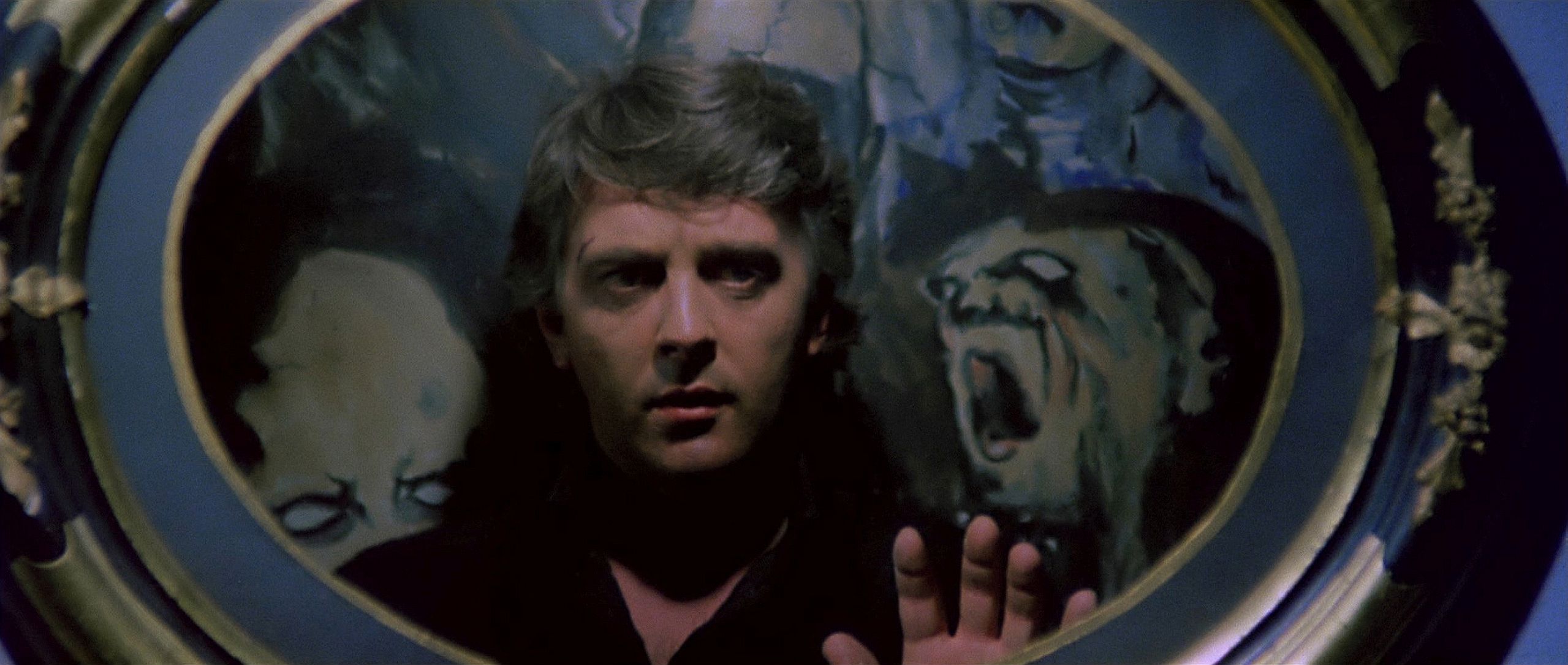Written by Dario Argento, Bernardino Zapponi
Directed by Dario Argento
Starring David Hemmings, Daria Nicolodi, Gabriele Lavia, Macha Meril
Released March 7, 1975 (Italy)
RT 126 min.
Home Video Arrow Video
Classic Horrors rating = 8 (out of 10)

More than one of the bonus materials on Arrow Video’s new two-disc Blu-ray release of Deep Red (Profundo Rosso) emphasizes the importance of its position on the timeline of director Dario Argento’s career. While movies like Mario Bava’s The Girl Who Knew Too Much aka Evil Eye and Blood & Black Lace were among the first gialli in the mid-1960s, it was the success of Argento’s first screenwriting and directorial effort, The Bird with the Crystal Plumage (1970) that caused an “explosion of gialli” in the 1970s. Argento himself completed his “Animal Trilogy” with The Cat o’ Nine Tails (1971) and Four Flies on Grey Velvet (1971), but then tried to escape the genre with a TV series and a historical comedy.
Experiencing little success with those projects, Argento returned to the genre that made him famous in 1975 with Deep Red; however, he took this as opportunity to deconstruct the giallo. In the audio commentary on disc one, “The Director’s Cut,” Danish filmmaker Thomas Rostock said he “turned giallo inside out.” And, in “Profondo Giallo,” a 32-minute visual essay, Michael Mackenzie calls Deep Red “a giallo to end all gialli.” Watching the movie before the bonus materials, my impression was that it was an epic giallo, a movie that took common tropes of the genre and maximized them through a style heretofore unseen from Argento. (And, at 126 minutes, it was the longest giallo ever made.)
It was also a movie in which Argento dipped his toes into the pool of the supernatural, a subgenre into which he would take a full dive two years later with Suspiria (1977). Deep Red opens at a “Parapsychology Congress” where guest of honor, Helga Ulmann (Macha Meril) senses a killer in the audience. We assume the killer is the same person whose silhouette repeatedly stabbed someone in front of a Christmas tree in a scene that interrupts and divides the opening credits, and concludes with a knee-down shot of a child standing by the bloody knife. Ulmann’s outburst during her presentation starts the story moving in present time when she’s later murdered in her apartment, I imagine so that the killer’s identity might never be revealed.

It’s also so that our hero, Marcus Daly (David Hemmings) can witness the murder from the street below, rush into the apartment to try to save her, see the killer escape, and then be compelled for the rest of the movie to solve the mystery. He’s obsessed with the idea that he saw something at the murder scene that he can’t remember, a typical giallo trope that Rostock calls in his commentary, “sensory recollection of a past event.” Another giallo trope is an ineffective police force that contributes to the hero conducting an investigation his/herself. In Deep Red, though, the police force is barely present at all. There’s no evidence that they’re even investigating the murder; although, perhaps Argento just chooses to not document their activity.
I’m not much interested in writing about the story of Deep Red. It’s the style that fascinates me, and that’s an interesting point considering the content of Mackenzie’s essay. He discusses how Argento films have been described in terms of style over substance. But Mackenzie argues, and I wholeheartedly agree, that the style is the substance. “Every element contributes to make a cinematic experience like no other. Argento rejects the orthodox view that plot is king. The narrative serves the spectacle, not the other way around.” Therefore, the scene in which Marcus witnesses Helga’s murder can take place on an impossibly empty street with a diner resembling the Edward Hopper painting, “Nighthawks,” and it somehow makes sense.

Mackenzie also references the idea that scenes of graphic violence in film are the equivalent of musical numbers in musicals. I apologize for not recalling the author of this idea, but he calls such scenes, “violence numbers.” In a musical or in a horror film, the musical numbers or the violence numbers are what people pay to see. It’s the visual set pieces, not the stories, that make the movies successful. Interestingly, I didn’t find the gore to be excessive in Deep Red; it’s been worse in other Argento films. However, related imagery definitely made me squirm, such as when Helga’s neck, resting on the broken glass of the window, slides further down, slicing her skin; or, when another victim’s mouth is slammed against the mantle, breaking his teeth.
Co-writer Bernardino Zapponi once said that the inspiration for Deep Red’s murder scenes came from him and Argento thinking of “painful injuries to which the audience could relate. The pain of being stabbed or shot is outside the experience of most viewers.” That makes sense. I’m not particularly afraid of being stabbed at home, but I’ve been cut by glass. It’s painful and I don’t like it. Thinking about it makes me cringe. I once had a window broken over my head and was taken to the emergency room. Don’t ask… college. Heck, paper cuts are even worse! Likewise, I’ve fallen and hit my face on concrete. I know what it feels like to chip a tooth and I certainly don’t want to imagine or see someone else losing one.
The “Export Version” included as disc two in this set runs only 105 minutes. From what I understand, it’s not so much the violence that was removed as it was the humor. Several romantic scenes between Marcus and reporter Gianna Brezzi (Daria Nicolodi) were trimmed or cut completely. This is a fascinating fact when you think about it… without the scenes that helped make Deep Red “the final word” in gialli, it really is just a typical giallo. So we have the best of both worlds in Arrow’s package, a movie for either preference: epic or standard. I’m torn between the two. The extra scenes do slow down the action and sometimes distract from the mystery. However, by the end, they do have their place in elevating the status of the film.

Bonus Materials:
- Italian theatrical trailer
- DEEP RED: EXPORT VERSION (BLU-RAY DISC 2) [LIMITED EDITION EXCLUSIVE]
- “Profondo Rosso: From Celluloid to Shop” a tour of the Profondo Rosso shop in Rome with long time Argento collaborator Luigi Cozzi
- “Music to Murder For!” Claudio Simonetti on Deep Red
- “The Lady in Red: Daria Nicolodi Remembers Profondo Rosso“
- “Rosso Recollections: Dario Argento’s Deep Genius,” the Deep Red director on the creation of a giallo masterpiece
- Audio commentary by filmmaker and Argento expert Thomas Rostock
- Introduction to the film by Claudio Simonetti of Goblin
- “Profondo Giallo,” a new visual essay by Michael Mackenzie featuring an in-depth appreciation of Deep Red, its themes and its legacy
- Brand new restoration from a 4K scan of the original negative
- DEEP RED: ORIGINAL VERSION (BLU-RAY DISC 1)
- Limited Edition booklet featuring new writing on the film by Mikel J. Koven, author of La Dolce Morte: Vernacular Cinema and the Italian Giallo Film, and an archival essay by Alan Jones, illustrated with original archive stills
- Reversible sleeve featuring original and newly commissioned artwork by Gilles Vranckx
- Reversible fold-out poster featuring two original artworks
- 6 postcard-sized lobby card reproductions
- Optional English subtitles for the deaf and hard of hearing for the English soundtrack
- English subtitles for the Italian soundtrack
- Original English soundtrack in lossless DTS-HA MA mono 1.0*
- High Definition Blu-ray (1080p) presentation of two versions of the film
- Original Italian soundtrack in lossless DTS-HD MA mono 1.0
- Optional surround sound remix of the Italian soundtrack in lossless DTS-HD MA 5.1
-
2-DISC LIMITED EDITION CONTENTS
- Brand new restoration from a 4K scan of the original negative
- US theatrical trailer
* The English audio track on the original, longer cut has some portions of English audio missing. English audio for these sections was either never recorded or has been lost. As such, these sequences are presented with Italian audio, subtitled in English.
Leave a comment